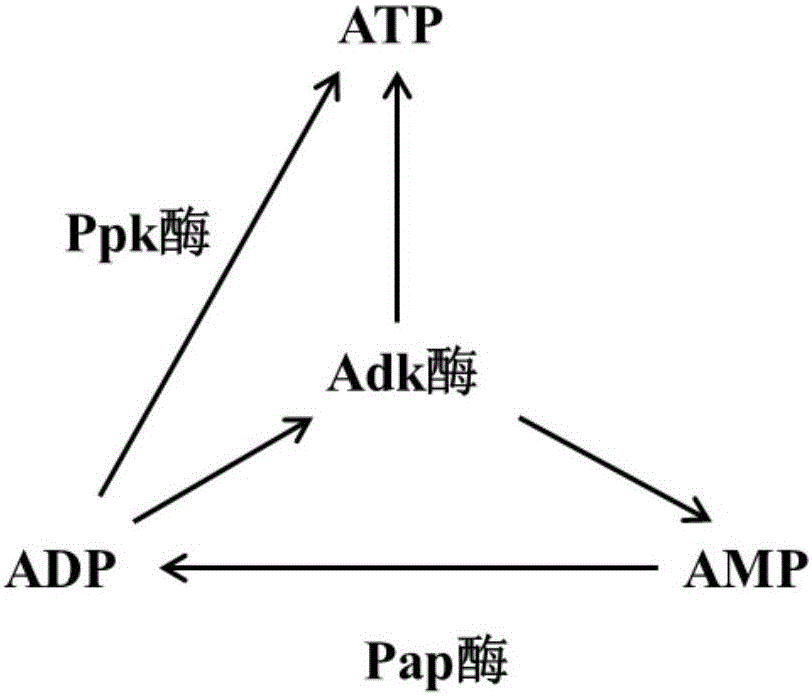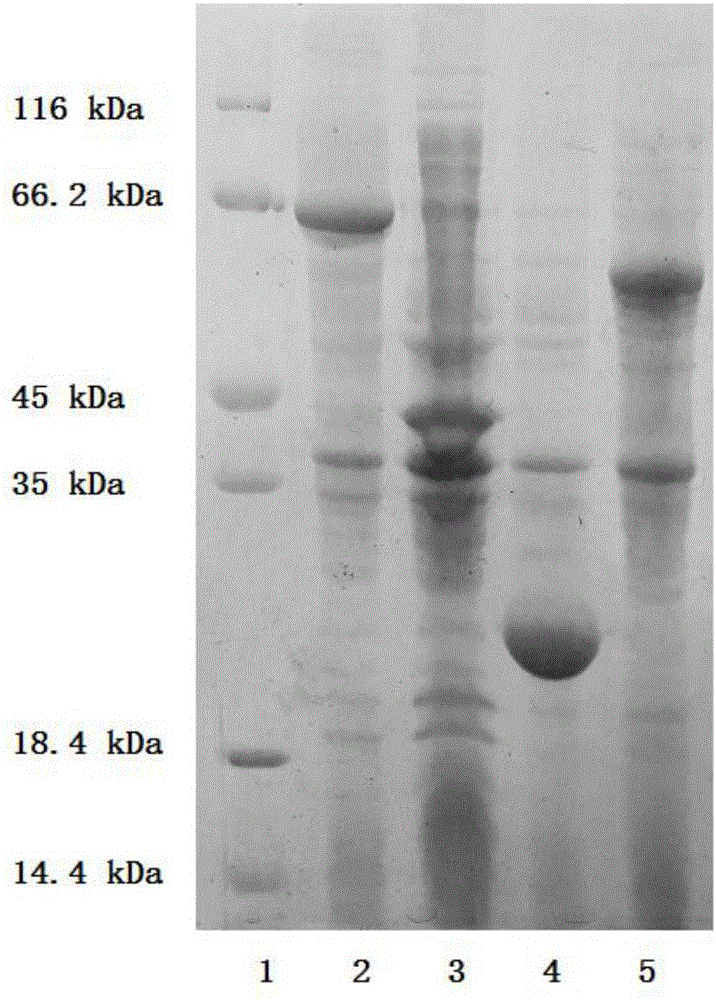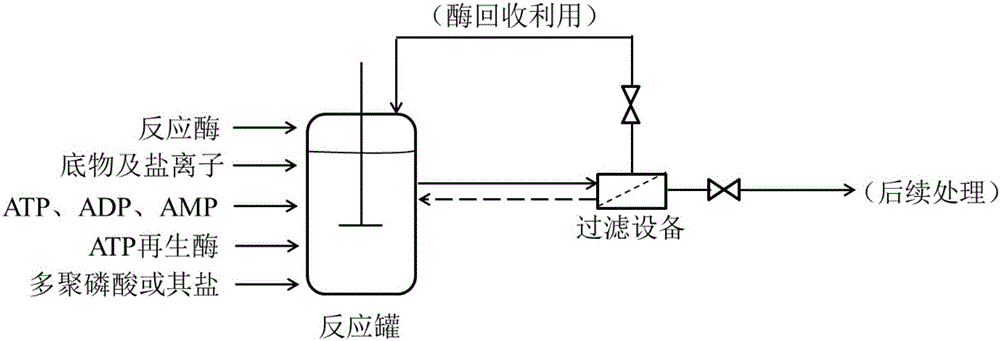Method for regenerating ATP (adenosine triphosphate) by enzyme process and application thereof
A regeneration reaction and enzymatic technology, applied in the biological field, can solve the problems of expensive substrates and difficult to use in large quantities, and achieve the effects of simple and efficient regeneration process, reduced usage and high stability.
- Summary
- Abstract
- Description
- Claims
- Application Information
AI Technical Summary
Problems solved by technology
Method used
Image
Examples
Embodiment 1
[0054] The preparation of embodiment 1Ppk, Adk and Pap enzyme
[0055] The Ppk (including Ppk1 and Ppk2), Adk and Pap enzymes in the method of the present invention can be obtained commercially, or can be artificially modified to have the same catalytic function.
[0056] The preparation process of Ppk1, Ppk2, Adk and Pap enzymes is as follows:
[0057] According to the sequences of the four enzyme genes, four pairs of amplification primers were designed and synthesized by Zhongmei Taihe Biotechnology Co., Ltd. The primer sequences are as follows:
[0058] ppk1 sense primer: 5'-CCATATGGGTCAGGAAAAGCTATACATCG-3';
[0059] ppk1 antisense primer: 5'-CGGATCCTTTATTCAGGTTGTTCGAGTGATT-3';
[0060] ppk2 sense primer: 5'-TACATATGGCCAGCCCGGCGCAGAAG-3';
[0061] ppk2 antisense primer: 5'-TGAATTCAGGCCGGGATATCCAGGTTC-3';
[0062] adk sense primer: 5'-CCATATGCGTATCATTCTGCTTGGCGCTCCGG-3';
[0063] ADK antisense primer: 5'-CGGATCCTTAGCCGAGGATTTTTTTCCAGATC-3';
[0064] PAP sense primer: 5...
Embodiment 2
[0073] Example 2 Enzymatic production of phosphocreatine-coupled ATP regeneration system
[0074] image 3 It is a process flow diagram of using free enzyme to carry out enzymatic reaction and coupling ATP regeneration system in the method of the present invention. see image 3 , Enzymatic preparation of creatine phosphate while coupling free ATP regeneration system steps are as follows:
[0075] (1) The reaction of synthesizing creatine phosphate and regenerating ATP in the reaction tank:
[0076] In the reaction tank, the reaction system of 100L sterile water contains substrate 1.5kg creatine, and 1.0kg ATP, 0.5kg disodium hydrogen phosphate, 0.38kg potassium chloride, 0.3kg sodium chloride, 0.2kg ammonium sulfate, The solution of 1.0kg magnesium chloride hexahydrate and 2.0kg sodium tetrapolyphosphate should be uniformly stirred to prevent precipitation during preparation. Adjust the pH value to about 7.5, add 500U / L creatine kinase, 500U / L Ppk2 enzyme, and 500U / L Adk e...
Embodiment 3
[0081] Example 3 Enzymatic production of 1,6-diphosphate fructose-coupled ATP regeneration system (immobilized enzyme)
[0082] Figure 4 It is a process flow chart of using immobilized enzyme to carry out enzymatic reaction to produce and coupling ATP regeneration system in the method of the present invention. see Figure 4 , the operation steps of the immobilized enzyme method to prepare 1,6-diphosphate fructose while coupling the ATP regeneration system are as follows:
[0083] (1) Immobilization of catalytic enzyme and ATP regeneration enzyme:
[0084] Catalytic enzymes fructokinase (FK) and phosphofructokinase (PFK) were obtained commercially, and together with the ATP regeneration enzyme Ppk2 enzyme and Pap enzyme initially purified in Example 1, they were immobilized on the commercial epoxy immobilized carrier LX1000EP.
[0085] Mix FK, PFK, Ppk2 and Pap enzymes according to the activity ratio of 1:1:1:1 to make 10L of mixed enzyme solution, and the activity of each ...
PUM
 Login to View More
Login to View More Abstract
Description
Claims
Application Information
 Login to View More
Login to View More - R&D
- Intellectual Property
- Life Sciences
- Materials
- Tech Scout
- Unparalleled Data Quality
- Higher Quality Content
- 60% Fewer Hallucinations
Browse by: Latest US Patents, China's latest patents, Technical Efficacy Thesaurus, Application Domain, Technology Topic, Popular Technical Reports.
© 2025 PatSnap. All rights reserved.Legal|Privacy policy|Modern Slavery Act Transparency Statement|Sitemap|About US| Contact US: help@patsnap.com



